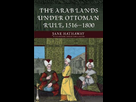The Arab Lands Under Ottoman Rule, 1516-1800 by Jane Hathaway is a survey history of the Ottoman Empire. The monograph emphasizes the study of diverse demographics and complex power structures that governed the Empire for 300 years. Hathaway's reassessment of the Ottoman Empire is contrary to current narrowly focused studies, either Arabic nationalistic or Ottoman centrist, and calls for a broader, more complex understanding of the dynamics of Ottoman imperium. This entire monograph becomes a driving critique of modern study while also detailing the historical narrative of the time in question.
In the monograph, Hathaway maintains that population diversity is overlooked by previous histories defining the Empire. She writes that the “complexion of 'local notables' varied from one province to another, and even from one district to another” and that “the demarcation between state and society was discursively constructed and was constantly being contested and negotiated.”(p. 9-10) Additionally “'demographic flux'... also characterized the region, with new populations sweeping in periodically from different directions.” (p. 34) Hathaway also critiques mono-thematic characterization of ayans as a isolated ruling class, championed originally by Albert Hourani in 1966, as “far too neat.” (p. 80) In line with other current studies of imperial history, the monograph maintains that the ruling elites were affected by their constituents more than previous historiography conceded. Hathaway's thus establishes an overarching theme of diverse, historically neglected groups that “played a critical, albeit frequently understudied, role in shaping [the Empire's] character.” (p.99)
Further, “neo-nationalistic” historiography has a “tendency to treat residents of the various Arab provinces as if they shared a tacitly acknowledged common identity.” (p. 246) Hathaway's work establishes that the Empire was not as simple conqueror versus conquered, but a vibrant organism with multitudes of varying interactions and people. For instance, “Turcophone Anatolians living in [Cairo] were not necessarily regarded as a completely alien presence,” as nationalistic theory would hold. (p. 247) She writes that “we should remember that the relationship between Ottoman central authority and any given province... was not a question of two rival power centres; rather, it resembled a dialogue or negotiation, with much give and take of personnel and resources.” (p. 112)
The failure to study marginalized peripheries in favor of elite groups is not new in Ottoman historiography. Specifically, Hathaway recalls “the 'decline' paradigm” that historically has been a central theme of Ottoman studies but since has been “cast aside.” (p. 89) She traces this theory back to previous historical study of “Ottoman intellectuals of the late sixteenth century” who believed “the empire was indeed in decline, and they wrote about their concerns” in advice literature. (p. 60) These authors led historians to conclude that after the reign of Sultan Suleyman I an age of corruption, military blunder, and financial collapse slowly eroded the Empire. As the 'decline theory' is based on accounts of intellectual elites it therefore becomes a hypothesis based on a demographic sampling error. Hathaway's monograph, thus, advocates diverse group studies to avoid such biases.
The Arab Lands Under Ottoman Rule, 1516-1800 addresses rather complex issues pertaining to the definition and taxonomy of empire. Much of Hathaway's work is reminiscent of Stoler and Cooper's Between Metropole and Colony in calling for a redefining study of the interactions between inhabitants in an imperial power. Therefore, the contribution of this work is enormous in the field of Ottoman history. Hathaway's inclusion of marginalized groups and analysis of the complex relationship dynamic between ruler and ruled is a valuable addition for Ottomanist scholars. Despite the survey style of this work, a fertile new field of inquiry has been opened. Intellectual, social, religious, and political history are all accounted for in this work. However, social history predominates and outshines the other fields. Further nuanced studies would strengthen her conclusions. Hathaway has provided the start, it is up to future historians to follow.
Zach Schulz's review








 Reply With Quote
Reply With Quote





























